

Haemodynamic - definition of haemodynamic in the Medical dictionary. Professor julia newton. Autonomic dysfunction (definition) at DuckDuckGo. Autonomic dysfunction. Dysautonomia. Dysautonomia (or autonomic dysfunction) is any disease or malfunction of the autonomic nervous system (ANS).
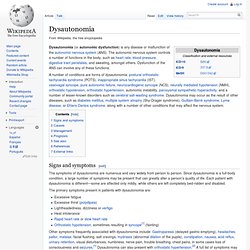
The autonomic nervous system controls a number of functions in the body, such as heart rate, blood pressure, digestive tract peristalsis, and sweating, amongst others. Dysfunction of the ANS can involve any of these functions. A number of conditions are forms of dysautonomia: postural orthostatic tachycardia syndrome (POTS), inappropriate sinus tachycardia (IST), vasovagal syncope, pure autonomic failure, neurocardiogenic syncope (NCS), neurally mediated hypotension (NMH), orthostatic hypotension, orthostatic hypertension, autonomic instability, paroxysmal sympathetic hyperactivity, and a number of lesser-known disorders such as cerebral salt-wasting syndrome. Signs and symptoms[edit] The symptoms of dysautonomia are numerous and vary widely from person to person. The primary symptoms present in patients with dysautonomia are: Causes[edit] Management[edit] Autonomic Dysfunction Center - Autonomic Dysfunction Center Home.
The Vanderbilt Autonomic Dysfunction Center was established in 1978 as the first international center for patient care, research, and training focusing exclusively on disorders of the autonomic nervous system.

Its creation brought together in one site a cadre of physicians, scientists and nurses who could foster a balanced scientific approach to elucidation of the etiology and optimal therapy of these disorders. Over the years, many people have contributed to this effort at Vanderbilt. Many of the young scientists and physicians who have trained here have gone out and established similar centers in other parts of the world. Others have taken positions at academic research centers and pharmaceutical firms where they are seeking improved drugs to treat these disorders. Signs and Symptoms of Autonomic Dysfunction. Definition and Patient Education. Part 1 of 6: Overview Overview Your autonomic nervous system is made up of nerves that control those “automatic” things you need to do to survive.
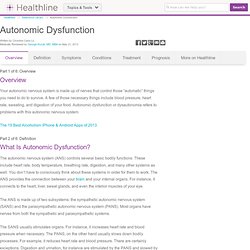
A few of those necessary things include blood pressure, heart rate, sweating, and digestion of your food. Dysautonomia Information Page. What is Dysautonomia?
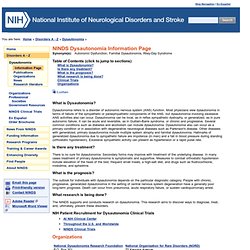
Dysautonomia refers to a disorder of autonomic nervous system (ANS) function. Most physicians view dysautonomia in terms of failure of the sympathetic or parasympathetic components of the ANS, but dysautonomia involving excessive ANS activities also can occur. Dysautonomia can be local, as in reflex sympathetic dystrophy, or generalized, as in pure autonomic failure.
It can be acute and reversible, as in Guillain-Barre syndrome, or chronic and progressive. Several common conditions such as diabetes and alcoholism can include dysautonomia. Is there any treatment? There is no cure for dysautonomia. What is the prognosis? The outlook for individuals with dysautonomia depends on the particular diagnostic category. What research is being done? The NINDS supports and conducts research on dysautonomia. Autonomic Dysfunction FAQ - FAQs - neurological disorders Health Pages. Autonomic Dysfunction FAQ Please add, edit, update, or modify as needed.

This is a work in progress. ← Back to Dysautonomia & Autonomic Dysfunction Index Page 1. What is the autonomic nervous system? 2. 3. Two of the most commonly occurring forms of Dysautonomia are Postural Orthostatic Tachycardia Syndrome (POTS), and Neurally Mediated Hypotention (NMH). 4. 5. Not every form of dysautonomia causes every symptom, nor does every patient experience the same group of symptoms. Autonomic-dysfunction. Autonomic Neuropathy. Somatic. English[edit] Etymology[edit] French somatique, from Ancient Greek σωματικός (sōmatikos, “bodily”), from σῶμα (sōma, “body”).
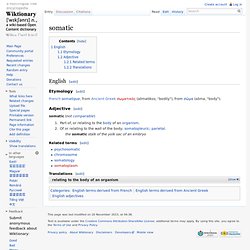
Adjective[edit] somatic (not comparable) Part of, or relating to the body of an organism.Of or relating to the wall of the body; somatopleuric; parietal. the somatic stalk of the yolk sac of an embryo Related terms[edit] Translations[edit] Autoimmune autonomic neuropathy (aan) Idiopathic Orthostatic Hypotension and other Autonomic Failure Syndromes. Primary syndromes of generalized autonomic failure include the following: Idiopathic orthostatic hypotension and other forms of pure autonomic failure (PAF)Autoimmune autonomic neuropathy (AAN)Multiple system atrophy (MSA) Unlike the above disorders, which each affect sympathetic and parasympathetic function, the autonomic condition postural orthostatic tachycardia syndrome (POTS) affects only sympathetic function.
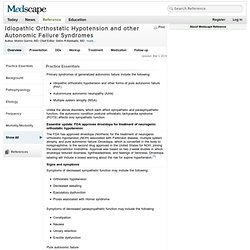
Essential update: FDA approves droxidopa for treatment of neurogenic orthostatic hypotension. Autonomic Dysfunction. Autonomic nervous system dysfunction.